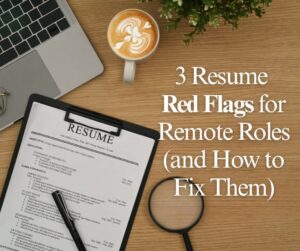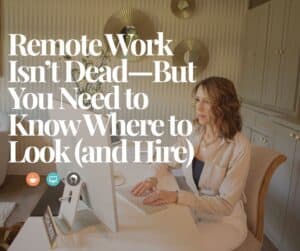3 Resume Red Flags for Remote Roles (and How to Fix Them)

Remote resumes reveal far more than job titles and skills. They reflect how well someone can operate autonomously, communicate asynchronously, and deliver results without daily supervision. For job seekers, that means your resume needs to prove you can thrive without constant oversight. For small businesses, it’s about spotting whether a candidate truly understands how distributed work operates. For both employers and job seekers, there are a few things that might show up as red flags in application materials, so our team has compiled remote job resume tips to help both sides evaluate readiness in a modern, tech-driven hiring landscape.
1. No Evidence of Remote Systems or Asynchronous Workflows
The Red Flag: A resume that lists “remote work” but doesn’t mention how the candidate managed it.
Employers scanning for remote-readiness look for specific collaboration systems, time-zone coordination, or asynchronous communication practices. If a candidate’s experience sounds like a traditional in-office role, that’s a sign they might not be fluent in remote dynamics.
For Job Seekers – How to Fix It: Reference concrete tools and processes that show operational maturity. Replace vague lines like “Collaborated remotely with team members” with quantifiable and context-rich examples:
“Used ClickUp and Loom to coordinate sprint planning across three time zones, reducing project delays by 15%.”
Mention async-friendly systems like Slack threads, Notion docs, Jira tickets, etc. and focus on measurable outputs, not just participation. Employers want to see that you understand digital accountability.
For Employers – What to Look For: Scan for tech literacy and process fluency. Candidates who can articulate how they structure work (task management tools, version control, or async updates) typically ramp up faster in remote roles. If you don’t see specific platforms or workflow verbs (e.g., “documented,” “automated,” “tracked”), it’s worth probing in the interview.
2. Metrics-Free Achievements
The Red Flag: Even talented remote professionals often undersell their work by focusing on duties rather than impact.
A resume that reads like a task list without numbers, efficiency gains, or measurable outcomes makes it hard for hiring teams to assess productivity and ownership, two cornerstones of remote work success.
For Job Seekers – How to Fix It: Quantify results. Data communicates self-management better than adjectives. Include time savings, productivity boosts, or deliverable counts:
“Automated weekly reporting using Google Sheets macros, cutting manual updates by 5 hours per week.”
If you can’t disclose numbers, use directional terms like “increased client retention,” “shortened response times,” or “expanded cross-team adoption.” These contextual cues show business thinking and independence.
For Employers – What to Look For: Candidates who provide metrics are generally more results-driven and proactive. Those who focus on tasks (“managed email inbox”) over impact (“reduced email response time by 40%”) may require more oversight. In remote setups, measurable outcomes often correlate with self-discipline and accountability.
3. Inconsistent Career Narrative
The Red Flag: Disjointed job histories like multiple short stints, gaps, or unrelated roles aren’t automatically negative, but they raise questions about reliability and adaptability.
In remote hiring, where trust and consistency matter, an unclear career story can suggest potential disengagement.
For Job Seekers – How to Fix It: Shape your timeline to show strategic transitions. Use grouping and context to explain flexibility without oversharing:
“Freelance Operations Consultant (2019–2022) – supported startups with remote onboarding and workflow optimization.”
Add brief one-liners for any pause in work, especially if it involves skill development, caregiving, or project-based work. Employers respect transparency paired with initiative to show how you stayed engaged, even informally.
For Employers – What to Look For: Instead of rejecting applicants with gaps, evaluate the continuity of skills. Do they demonstrate progressive improvement, new certifications, or a steady remote toolkit (Zoom → Notion → ClickUp)? Candidates who show learning momentum often outperform those with linear but static resumes.
Building Smarter Remote Matches
A strong remote resume is a systems map that reveals how someone works, communicates, and self-regulates. For candidates, that means going beyond buzzwords to demonstrate digital fluency and measurable results. For employers, it means recognizing that “red flags” often signal missing context, not disqualification.
Small businesses that hire experienced moms for remote jobs or post flexible jobs online should focus less on perfect formatting and more on operational evidence: tools, metrics, and continuity. When both sides approach resumes as process documents, not just job histories, the result is faster onboarding, clearer expectations, and stronger long-term partnerships.
Job seekers, ready to get started? Find a job.
Employers ready to find your dream candidate? Post a job.








